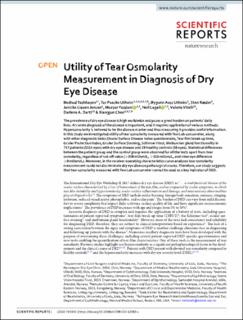Utility of Tear Osmolarity Measurement in Diagnosis of Dry Eye Disease
Tashbayev, Behzod; Utheim, Tor Paaske; Utheim, Øygunn Aass; Ræder, Sten; Jensen, Janicke Cecilie Liaaen; Yazdani, Mazyar; Lagali, Neil Satish; Vitelli, Valeria; Dartt, Darlene Ann; Chen, Xiangjun
Peer reviewed, Journal article
Published version
Permanent lenke
https://hdl.handle.net/11250/2722472Utgivelsesdato
2020Metadata
Vis full innførselSamlinger
Originalversjon
Tashbayev, B., Utheim, T. P., Utheim, Ø. A., Ræder, S., Jensen, J. L., Yazdani, M., Lagali, N., Vitelli, V., Dartt, D. A. & Chen, X. (2020). Utility of Tear Osmolarity Measurement in Diagnosis of Dry Eye Disease. Scientific Reports, 10, 5542. https://doi.org/10.1038/s41598-020-62583-xSammendrag
The prevalence of dry eye disease is high worldwide and poses a great burden on patients’ daily lives. Accurate diagnosis of the disease is important, and it requires application of various methods. Hyperosmolarity is believed to be the disease marker and thus measuring it provides useful information. In this study we investigated utility of tear osmolarity measured with TearLab osmometer, along with other diagnostic tests (Ocular Surface Disease Index questionnaire, Tear film break-up time, Ocular Protection Index, Ocular Surface Staining, Schirmer I test, Meibomian gland functionality in 757 patients (1514 eyes) with dry eye disease and 29 healthy controls (58 eyes). Statistical differences between the patient group and the control group were observed for all the tests apart from tear osmolarity, regardless of cut-off value (>308 mOsm/L, >316 mOsm/L, and inter-eye difference >8 mOsm/L). Moreover, in the receiver operating characteristics curve analyses tear osmolarity measurement could not discriminate dry eye disease pathological scores. Therefore, our study suggests that tear osmolarity measured with TearLab osmometer cannot be used as a key indicator of DED.

